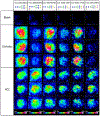Glycan Imaging Mass Spectrometry: Progress in Developing Clinical Diagnostic Assays for Tissues, Biofluids, and Cells
- PMID: 34020762
- PMCID: PMC8862151
- DOI: 10.1016/j.cll.2021.03.005
Glycan Imaging Mass Spectrometry: Progress in Developing Clinical Diagnostic Assays for Tissues, Biofluids, and Cells
Abstract
N-glycan imaging mass spectrometry (IMS) can rapidly and reproducibly identify changes in disease-associated N-linked glycosylation that are linked with histopathology features in standard formalin-fixed paraffin-embedded tissue samples. It can detect multiple N-glycans simultaneously and has been used to identify specific N-glycans and carbohydrate structural motifs as possible cancer biomarkers. Recent advancements in instrumentation and sample preparation are also discussed. The tissue N-glycan IMS workflow has been adapted to new glass slide-based assays for effective and rapid analysis of clinical biofluids, cultured cells, and immunoarray-captured glycoproteins for detection of changes in glycosylation associated with disease.
Keywords: Biomarkers; Clinical diagnostics; Glycosylation; Imaging mass spectrometry.
Copyright © 2021 Elsevier Inc. All rights reserved.
Conflict of interest statement
Disclosure R.R. Drake, P.M. Angel, and A.S. Mehta disclose partial ownership interests in 2 companies: GlycoPath, LLC, Mt Pleasant, South Carolina, and N-Zyme Scientifics, Doylestown, Pennsylvania.
Figures





References
Publication types
MeSH terms
Substances
Grants and funding
LinkOut - more resources
Full Text Sources
Other Literature Sources
Medical

